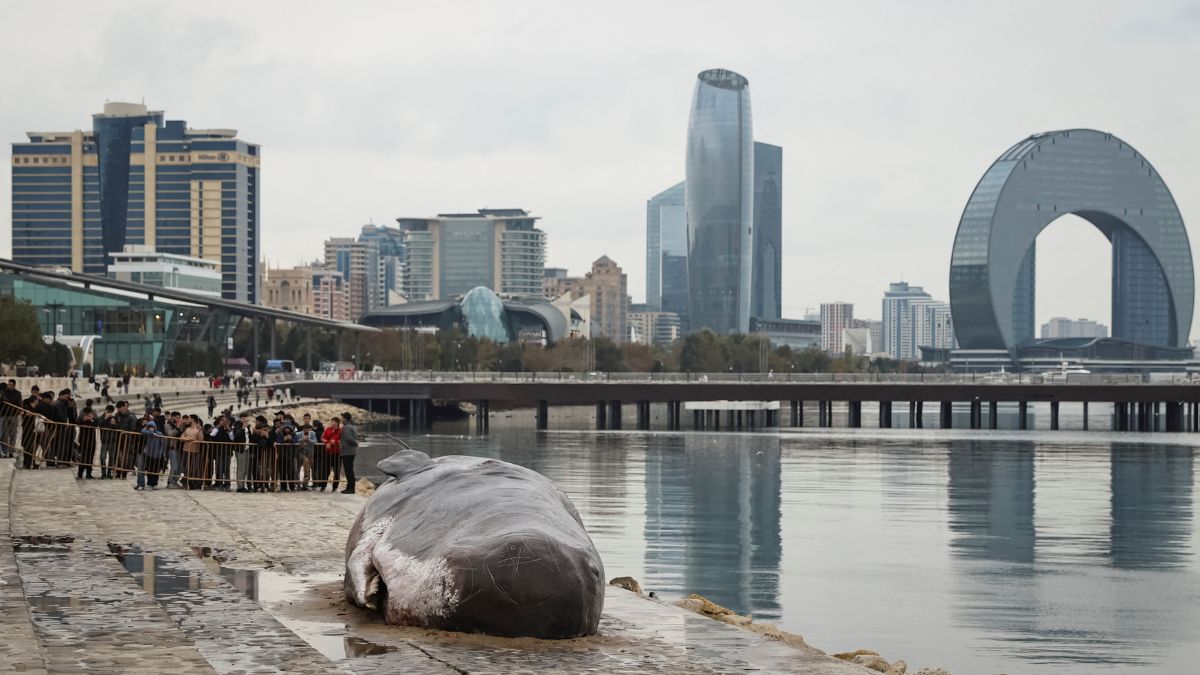The United Nations COP29 climate summit is currently underway in Baku, Azerbaijan, with representatives from nearly 200 countries attending the event. However, crowds have gathered in the city for another reason entirely.
A massive, foul-smelling, 52-foot sperm whale has been seen on the shores of the Caspian Sea - an unusual sight in the world’s largest enclosed lake, which has no known population of sperm whales.
Since Monday, residents have flocked to the shoreline to see this giant marine mammal up close.
ALSO READ | Climate change: 7 things that COP29 summit at Azerbaijan’s Baku needs to focus on
What’s so special about it?
According to CNN, the Baku residents might be surprised since sperm whales do not inhabit this isolated sea. The sight - and stench - of the whale has made it an unexpected attraction amid the climate summit.
But there’s a twist
The massive dead whale on Baku’s shores is not real - it’s a hyper-realistic model created by ‘Captain Boomer’, a Belgium-based collective of actors, sculptors, and scientists.
The collective installed the replica with permission as world leaders gather for the COP29 climate summit. The conference, which began on Monday in Azerbaijan, focuses on financing to support developing nations affected by climate change.
Since its creation over a decade ago, this model whale has been displayed across cities and coasts, including locations in Europe and Australia.
“When we think the story is right, we pop up in a city,” Bart Van Peel from Captain Boomer told CNN.
The journey from Belgium to Azerbaijan took two weeks and the model was transported through Europe, Turkey, and Georgia before reaching Baku. Local activist Adnan Hussein, founder of the FINS initiative for marine conservation, helped secure Azerbaijani authorities’ approval to keep the installation on display throughout the climate summit.
What’s the reason behind the installation of the model?
The model whale in Baku is meant to raise awareness about the global ecological crisis, especially the human-driven climate challenges threatening marine life.
Created with moulds from real whales while the smell comes from buckets of rotting fish, the installation is designed to feel unsettlingly real. The whale model is a “gigantic metaphor for the disruption of our ecological system,” the collective described on its website.
Speaking to CNN, Van Peel said that the motive is to play with fact and fiction to challenge people’s beliefs and make them think. The animal makes “people feel that their bond with nature is disturbed,” he said.
Captain Boomer’s team also hosts performances around the model, playing roles as scientists investigating the supposed whale’s death. They even operate under the fictitious North Sea Whale Association, performing mock autopsies and dissections to heighten the sense of realism.
To keep the illusion convincing, the team hides buckets of rotting fish around the installation, adding a rancid aroma to make the display feel as lifelike as possible.
As climate change continues to warm oceans, whales face increased risks, including food scarcity, disrupted migration, and threats from human activity. Rising ocean temperatures impact whales by disrupting their food sources, which can push them to change their migration paths. This, in turn, strengthens their vulnerability to human activities like shipping and fishing.
Van Peel explained that the whale’s silent presence feels like a powerful statement: “It’s this gesture of a beast coming from another element and throwing itself at our feet and saying: ‘Look, I can’t anymore.’” The installation has already attracted thousands, leading people to linger, and reflect on the whale’s message.
He said that some have stayed more than an hour and many have had “very emotional reactions.”
What is the COP29 climate change summit?
The COP29 climate change summit is a key United Nations event which brings together representatives from 197 countries under the United Nations Framework Convention on Climate Change (UNFCCC).
ALSO READ | COP29: What is Article 6? How will it help reduce carbon pollution?
Held over 12 days, it includes diplomats, scientists, activists, businesses, and environmental organisations, all focused on preventing “dangerous” human-caused climate impacts.
The conference discussions are focused on a funding approach that combines commitments from wealthy nations with contributions from multilateral institutions and private investors. However, negotiations are challenging, as there is an ongoing debate over which nations should fund climate initiatives.
While historically only wealthy countries were required to contribute, there is increasing pressure for rapidly developing economies, like China and Gulf oil-rich nations, to participate financially. China, however, resists, defending its developing-nation status.
‘We are on the road to ruin’
This year is on track to reach 1.5 degrees of warming, potentially making it the hottest in recorded history. COP29 President Mukhtar Babayev said that the effects of climate change in natural disasters like hurricanes, droughts, and floods are already here and hurting.
“We are on the road to ruin,” Babayev said. “Whether you see them or not, people are suffering in the shadows. They are dying in the dark. And they need more than compassion. More than prayers and paperwork. They are crying out for leadership and action.”
Notably, political shifts over the past year, particularly in the United States - the world’s largest historical carbon emitter - and Germany, a leader in climate policy, are affecting negotiations at COP29.
The election of Donald Trump, who disputes climate change and its impact, and the collapse of Germany’s coalition government are now changing the dynamics of global climate agreements, experts said.


)

)
)
)
)
)
)
)
)



